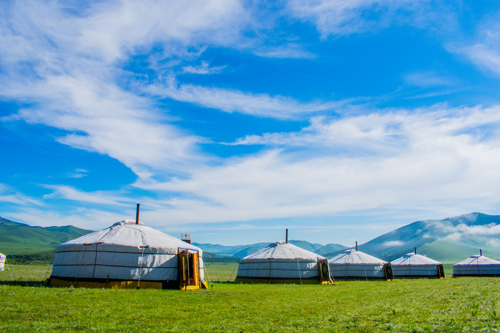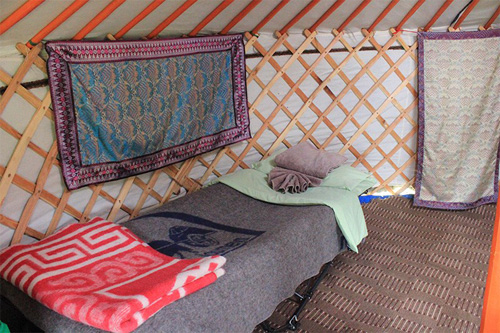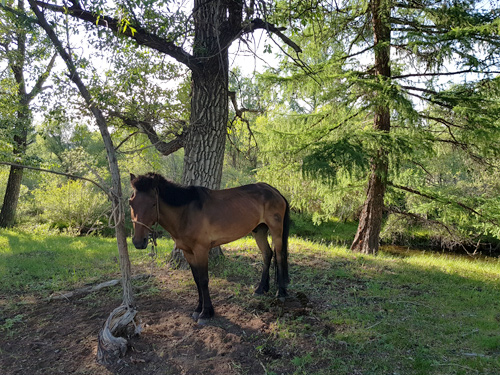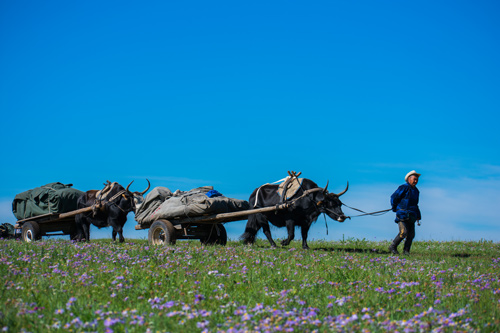Big Sky Trail
Khan Khentii Mongolia: (IT-MNRT11)
URL: https://www.hiddentrails.com/tour/mongolia_big_sky_ride.aspx
Introduction
Khan Khentii
Mongolia
On this horse riding tour, you can ride Mongolian horses and gallop through the Genghis Khan’s (Chinggis Khaan) homeland. Luxury camping in a Mongolian yurt (ger) makes it truly unique experience!
Group size is half of that of our regular horse riding tour, giving you a more personalized and intimate experience. We will start this horse ride by a short drive to the taiga life zones of Khan Khentii and we will be dropped off at the Upper Tuul River to meet our local crew of horsemen. They have deployed our personal Mongolian yurt (ger) at the site already. All riders overnight in Mongolian yurt (ger), which are being moved to a new location – by yak cart caravan – every two days. This allows us to explore deeper into the nomadic lands. For the outdoor camping you will be able to stay in the basic comforts of a bed (sturdy cot) with full linens and a ger heated by a stove, ensuring a good night's rest from long riding days. After a day trial ride in the vicinity (two overnights) we continue to ride our Mongolian horses in a truly nomadic way, e.g. without vehicle support in wild terrain. We are supported by a caravan of yak carts and local nomads. Our luggage and a fully collapsible ger lodge will be loaded on to yak carts. We will ride in daily big loops while the caravan makes its way to our next night scenic night stops. We will ride over mountains, steppes, forests and wooded meadows,-mostly camping stream side along rivers. This horse riding tour will cover the southern fringes of the Khan Khentii in scenic interior of Gorkhi Terelj National Park, which is mountain forest taiga zones. We will ride on the same path as the famous Genghis Khan (Chinggis Khaan), reliving history.
Accomodation

Accommodations
This is a progressive ride, so you will be staying in different locations during the trip.
Description
You will be staying in a hotel for 2 nights, a low-impact ger camp for 2 nights, and ger outings for 6 nights (changing location every 2 nights), making a total of 5 different locations. All accommodations are based on double occupancy. Private bathrooms are only available for nights spent in Ulaanbaatar. On all other nights, facilities are shared.
Accommodation Itinerary - subject to changes based on availability
Night 1: Bayangol Hotel in Ulaanbaatar
Night 2-7: Ger Outing
Night 8 and 9: Low-impact ger camp in Jalman Meadows
Night 10: Bayangol Hotel in Ulaanbaatar
Bayangol Hotel in Ulaanbaatar
Ideally located in the city center, this hotel offers elegant and comfortable ensuite bedrooms. Each room is equipped with air conditioning, a TV, free Wi-Fi access and tea and coffee making facilities. Laundry is available for an additional cost.

Ger Outing
On most nights, we sleep in temporary camps in 1 to 3 gers set up. The gers are each equipped with cot beds (including full linen), chairs and a table, and a wood burning stove. We take along a Mongolian ger (yurt) to serve as our mobile restaurant. Toilets tents with a drop toilet with wooden seat and separate shower tents are on site. We ask our clients to bring bio-degradable toiletries only.
Low-impact ger camp in Jalman Meadows
This is a permanent camp where each ger is equipped with cot beds (including full linen), chairs and a table, and a wood burning stove. There are also toilets tents with a drop toilet with wooden seat and separate shower tents are on site. Showers are also on site. We ask our clients to bring bio-degradable toiletries only.
Room Occupancy
Triple occupancy is possible.
Single riders listed as 'willing to share' do not have to pay the single supplement cost if we are unable to find another rider to share.

Meals
All meals except lunch in Ulaanbaatar are included in the trip.
Our cook will prepare the meals. We pride ourselves in having excellent cooks adept at both western and Mongolian cooking on our trips. We can usually buy fresh milk and yogurt from local herdsmen. Traditional Mongols mostly eat meat and milk products. Mongolians who live in the city have adopted Russian and Western food habits. Although, they still like the traditional foods of the countryside, and frequently also eat these. The cuisine features lamb and mutton, the Kazakhs in western Mongolia prefer goat. We usually boil water all the time, and your water bottle may be filled in the evening. Alcohol is not allowed on this trip.
Dietary Restrictions
We can cater for vegetarians. Please make sure to advice us in advance of any dietary requirements that you may have.
This trip includes
and can accommodate special dietary requests.
Riding

Mongolia is probably the most equestrian nation in the world. Not only is the Mongol heritage and lifestyle intimately connected with the horse, Mongolia is an exceptionally inviting place for keen horse riders. The absence of fences and the vast expanses of the steppes and forests are ideal for uninterrupted and scenic riding at its best!
We emphasize the quality of human contacts and encounters with local people and respect for the horse and local equestrian traditions, from which many lessons can be learnt.
On this tour, apart from the short drive to the the starting point of our horse riding adventure and back to the city we will not rely on
any motor vehicle support. Instead we utilize
traditional wooden carts, that Mongolian families
still use moving from one pasture to another.
On this tour, apart from the short drive to the starting point of our horse riding adventure and back to the city we will not rely on any motor vehicle support. Instead we utilize traditional wooden carts, that Mongolian families still use moving from one pasture to another.
Riding Experience
You should be a competent rider, fit and capable of riding at all paces confidently. Varying terrain, in the saddle for several hours on most days.
Tack
We will provide you Russian saddles, which are more convenient for "western bottoms" than the Mongolian equivalent. We provide a saddle bag if needed.
Staff
A Mongolian English speaking guide will accompany the group at all times. A cook will follow with the yak cart caravan. In addition, the services of local herdsmen will be employed along with their animals. The horsemen follow a traditional lifestyle in the areas where we will be riding. If the group consists of 4 riders or more, we will also have a Mongolian doctor come along as part of the crew. We are supported by a caravan of yak carts and local nomads.
Itinerary

Sample Itinerary - subject to changes
Day 1: Arrival
Arrive in Ulaanbaatar. Transfer to your hotel. Tour briefing, followed by dinner and entertainment.
Meals included: Dinner
Overnight at Hotel in Ulaanbaatar
Day 2: To Bosog Meadows
Visit the Gandan lamasery, possibly in time for the prayers, center for the Buddhist revival in Mongolia. The Mongols follow the Tibetan version of Lamaism, Dalai Lama being the supreme theocratic leader. We then drive out of the city, and gradually the Mongolian landscapes unfolds before our eyes. By the time we come to the Hadan Hoshuu steppes valley, there are no traces of the so-called civilization any more. Another world of pastoralist nomads with their horses, gers and livestock are making use of this summer pasture. Picnic lunch en route. We will cross across the forested Zamtiin Pass into the Upper Tuul River Valley. We will meet the yak carts and the horses at Bosog Meadows, streamside of the Tuul River. We will spend two overnights here. Each ger will have a stove and strong cots with full bedding.
Meals included: Breakfast, Lunch & Dinner
Overnight at Ger Camp
Day 3: Tuul River Ride
After a night under the stars in our luxurious ger (yurt) tented camp, we will make a full day trial ride on the southern side of the Tuul River, up the valleys, forests and on to the ridges with stunning panoramic views of the habitat of southernmost Siberian forests as it makes the transition to Mongolian steppes. We will now ride along with the yak carts downstream along the tiny Baruunbayan until we come to the large meadows by the Tuul River. Again cross the Tuul River with the horses while our caravan heads straight for our Bosog Meadows, which will be our last night stop. Full day ride loop out of Bosog Meadows will bring us up the valleys and ridges on the southern side of Tuul River.
Meals included: Breakfast, Lunch & Dinner
Overnight at Ger Camp
Day 4: Bosog Meadows to Baruunbayan Valley
The day before our entire camp of gers (yurts) have already been loaded on the yak carts, and now our luggage is being loaded before breakfast. Our support structure is free from vehicles. All our provisions, camping equipment, luggage’s will be loaded on to yak carts. We will ride and make way north towards the Hentii Mountains, across the forested ridge into the next valley, the Baruun-bayan, where we will again spend another two overnights. Riders will separate at some point and ride a most scenic loop.
Meals included: Breakfast, Lunch & Dinner
Overnight at Ger Camp
Day 5: Gunjin Sum Ride
Today, we will make a full day ride excursion from our new base camp at Baruunbayan River, to Gunjin Sum, a temple ruin hidden in the forest.
Meals included: Breakfast, Lunch & Dinner
Overnight at Ger Camp
Day 6: Baruunbayan Valley to Zuunbayan Valley
Pack up and load the caravan for the last time. We set out separating ourselves from the yak carts caravan riding up the partly forested ridges. Most trees as larch, however some of the ridges there are larger patches of pine, there is a real possibility to come across the rare black-billed capercaillie. Black grouse are more common. Our ger camp will be built next to the Zuunbayan River, a tributary of the Tuul River. We spend two nights at this place.
Meals included: Breakfast, Lunch & Dinner
Overnight at Ger Camp
Day 7: Khentii Mountains Ride
We will ride up towards the treeline of the Khentii Mountains, with spectacular scenery and views in all directions.
Meals included: Breakfast, Lunch & Dinner
Overnight at Ger Camp
Day 8: Zuunbayan Valley to Jalman Meadows
Today we say goodbye to the herders and their yak carts caravan, and head on horse back to the Sharbulag Valley, crossing the uppermost parts of the Tuul River. We reach the small ger camp at Jalman Meadows midafternoon. Stay overnight in the ger camp.
Meals included: Breakfast, Lunch & Dinner
Overnight at Ger Camp
Day 9: Jalman Meadows Ride
A full day to enjoy the setting of Jalman Meadows Ger Camp. You may use the day for an additional half or full day ride. Or lean back in the library ger with good reads on Genghis Khan, contemporary Mongolia or horses for that matter. If you like to replace the ride with a float on Russian catarafts down-stream using inflatable rafts which will be loaded to a yak cart and taken to the river side. There is also a possibility of a river side sauna at streamside.
Meals included: Breakfast, Lunch & Dinner
Overnight at Ger Camp
Day 10: Back to Ulaanbaatar
A.m. Return to Ulaanbaatar and check into the hotel. See the capital city on your own. Dis-tances are short. The local guide is standing by to assist where your points of interest are located. We will have a farewell dinner in a local restaurant and entertainment.
Meals included: Breakfast & Dinner
Overnight at Hotel in Ulaanbaatar
Day 11: Departure
Transfer out to your next destination.
Meals included: Breakfast

Naadam Games Extension (mandatory for July 9th, 2020 departure)
July 9th Ulaanbaatar
Arrive in the Mongolian capital by flight. If you arrive today we provide transfer to your hotel. You may explore the city on your own for the rest of the day. Distances are short and nearly all points of interest can be reached by foot. Minor archery competitions and trainings will already start today such as children’s archery, Buryat style archery, etc. Training sessions allow for good photography. In the evening the horse trainers arrive with their horses and pitch their mobile camps at Hui Doloon Hudag, a steppe area 40 km away from the city center. In the evening we meet for a festive welcome dinner.
July 10th Ulaanbaatar
Today, one day before the National Naadam officially begins, we will drive out of the city and attend smaller, more intimate "country-style" Naadam festivals, usually held in three communities some 50-60km away. This failing, the big horse races also start on the Hui Doloon Hudag plains today. In the countryside you have the chance to get up close to the horse races, and also to the wrestling matches. Local people usually wear their finest traditional dresses, adding to the colorful, festive atmosphere. We have a picnic lunch nearby and head back to Ulaanbaatar in the afternoon.
July 11th Ulaanbaatar
Today Naadam is officially opened by the President of Mongolia. Soldiers on horseback, dressed in warrior regalia, ceremonially bring Genghis Khan's nine white horsetail banners from the parliament, where they are normally displayed, to the stadium. We will attend the impressive opening ceremony, after which the first round of wrestling will immediately follow. In most years 512 wrestlers from all over Mongolia compete, but in some years there are 1024! There are no judges, no time limits and no weight limits. We may try and attend the archery competitions (if not done the previous day) and later make our way out to the steppe area on the fringes of the city, where the horse races take place. We visit the nomadic tented camps that have sprung up, and experience a concentrated version of nomadic Mongolia. Herdsmen have come with their horses and all provisions for the festivities, which of course include airag (koumiss; fermented mares milk) for the merry making. Stroll around the area and you are likely to be invited in somewhere. You may also try your luck at the finals of the horse races, but prior instructions are necessary, since the finishing line of a full horse race of several hundred, is a potentially hazardous environment.
July 12th Ulaanbaatar (same as Day 1 for the standard itinerary)
Our services end after breakfast for the Naadam Games. You will be staying at the same hotel. Free day to explore Ulaanbaatar. Tour briefing after dinner.

Rates and Dates for Big Sky Trail
Rates include:
Accommodations, Most meals, 8 riding days & Transfers
There are other language guides such as Russian, French, German, Italian, Korean etc. available at additional cost
* prices are per person based on double/twin occupancy
Transfer and Other Charges:
|
2023
|
Transfers from/to Ulaanbaatar airport included
|
$0
|
|
2023
|
Single supplement for room in UB/sgl ger in Jalman Meadows (4n)
|
$240
|
|
2023
|
Single supplement for ger (6n)
|
$2,000
|
|
2023
|
No single supplement if willing to share
|
$0
|
|
2023
|
Private trip supplement (2-3 people) per trip
This is a "Group Rate"
|
$600
|
|
2023
|
Private trip supplement (4+ pax) - no extra charge
|
$0
|
Dates Note:
Rates do not include:
Gratuities, Airport departure tax, Lunches & Dinners in Ulaanbaatar (except for welcome and farewell dinner), Alcoholic drinks & Health and accident insurance (mandatory)
Other Info
Meeting: Ulaanbaatar
Airport: Chinggis Khaan International Airport (UBN)
Transfer: Ulaanbaatar
Climate:
Ulaanbaatar area
|
Month
|
Jan
|
Feb
|
Mar
|
Apr
|
May
|
Jun
|
Jul
|
Aug
|
Sep
|
Oct
|
Nov
|
Dec
|
|
Average High Temperature (°F)
|
4
|
14
|
30
|
48
|
62
|
72
|
76
|
72
|
61
|
45
|
23
|
7
|
|
Average Low Temperature (°F)
|
-20
|
-14
|
3
|
20
|
34
|
46
|
52
|
48
|
34
|
19
|
-1
|
-15
|
|
Average High Temperature (°C)
|
-16
|
-10
|
-1
|
9
|
17
|
22
|
24
|
22
|
16
|
7
|
-5
|
-14
|
|
Average Low Temperature (°C)
|
-29
|
-25
|
-16
|
-6
|
1
|
8
|
11
|
9
|
1
|
-7
|
-18
|
-26
|
|
Average Precipitation (days of rain)
|
0
|
0
|
0
|
0
|
1
|
3
|
4
|
3
|
1
|
0
|
0
|
0
|
Source: NOAA
Seasons
The mean elevation of Mongolia is about 1400 meters above sea level (5000 ft), which enhances the sharp continental climate. Mongolia has the highest atmospheric pressure in the world and the pronounced elevation as well as the distance from the moderating effects of the oceans, makes Ulaanbaatar the coldest capital city on Earth. This fact does not rule out extreme heat waves in the middle of the summer. In Mongolia the Central Asian desert zones meet with the Siberian taiga, hence, Mongolia is a transition zone with climatic extremes. Most of the year it is very cold, especially at night.
Winter
Precipitation is low and skies are usually clear during the wintertime.
Summer
Summers are very pleasant just as in the US and Europe. There is a short rainy season in July and August during which most of the annual rain will fall. Around 70 percent of all precipitation falls during this period. When raining it tend to be heavier and shorter, if extended it may cause floods locally. Occasional strong winds can come and go quickly. Even if this sounds like a lot of precipitation during the summertime it is just about the same as in Europe at the equivalent time. Mongolia is known as the land of the blue sky and throughout the year there are 278 sunny days and 9-23 cloudy days.
Spring and fall pass very quickly.
What To Bring:
Dress is very informal but Mongolian sensibilities dictate a degree of modesty in the cut of the clothing worn. Hotel laundry services are available but you will need to bring two or three changes of clothing for the camping portion of the trip. This basic list will be adequate for the demands of our trips. While in Mongolia we will have weather in the 60's and 70's during the day, but nights will be cold. If you are passing through Beijing on the way to or from Mongolia, be aware that Beijing is hot and humid.
Useful items:
Small binoculars, travel alarm clock, earplugs, journal and pen, pocket knife (put in checked luggage, not allowed as carry‑on), lightweight snacks like granola bars, fruit bark, jerky, trail mix, nuts, tea bags that you can't start the day without, vitamins, water purification tablets, Mongolian phrasebook.
Our support structure is free from vehicles. All our provisions, camping equipment, luggage will be loaded on to yak carts. Even a ger (yurt) will be brought, and we will learn how to use it.
| … this list is only a guideline for you |
|
|
| Travel documents and Voucher |
| Flight tickets |
| Passport |
| Visa (check with your consulate) |
|
|
| RIDING GEAR |
| Comfortable riding jeans or Jodhpurs |
| Riding boots (well broken in) or ankle-high riding shoes meant for endurance rides or ‘ride & ties’. These work especially well when worn with a pair of ‘half chaps’ (knee-high leather gaitors). They have a riding heel, but are comfortable enough to be used for your city and village footwear too. |
| Rubber overboots, especially if your riding boots have leather soles. |
| Riding gloves |
| Hat (with chin strip) for sun protection |
| Good rain gear: parka and rain pants or “duster” (no ponchos) |
|
|
| PERSONAL CLOTHING |
| Pile jacket or down vest |
| Wool sweater or wool shirt |
| Warm gloves |
| wool cap or other warm hat |
| Comfortable T-Shirts/Shirts |
| Jeans |
| Shorts |
| Underwear and socks |
| Long underwear for cold nights (polypropelene or capilene) |
| Women: Jogbra or other suitable sporty support |
| Pyjama |
| Bag for dirty clothes |
| Comfortable footwear for city and village walking (sturdy walking shoes or tennis shoes or lightweight hiking boots well broken in) |
| Swimsuit |
| Bandana or scarf |
| |
| ADDITIONAL THINGS TO BRING |
| Personal Toiletries |
| Insect protection |
| Personal medications |
| Sore cream (for the emergency) |
| small towel |
| Camera and enough extra films and batteries |
| Belt pack |
| Sun glasses with strap |
| Sun tan lotion and lip balm |
| Biodegradable campsuds |
| Minimum 1 liter water bottle (leather bota bags work great for riding) |
| Flashlight with change of batteries |
| Toilet paper |
| Extra baggage tags ("collecting" tags is popular with baggage handlers in Asia) |
| 6 small & medium zip loc bags for trash disposal |
| Luggage padlocks |
| Nylon parachute cord (useful for tying rain gear and saddle bags behind saddle) |
|
|